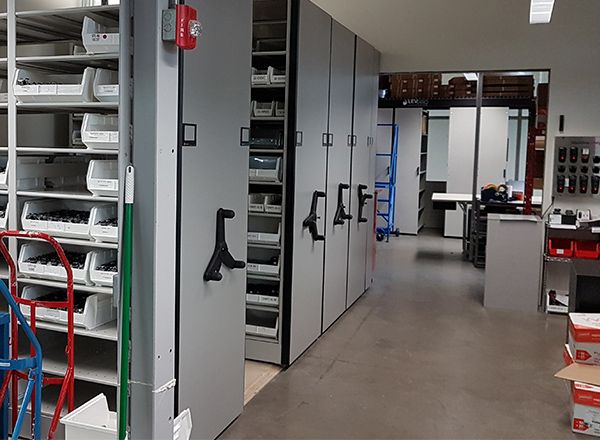In today’s fast-paced world, businesses, warehouses, and offices require efficient storage solutions to maximize their space while ensuring easy access to their stored goods. A mobile shelving system offers a versatile and dynamic way to achieve this. These systems allow shelves to move easily, enabling better organization and the ability to adjust storage layouts as needed.
This article will explore the benefits of mobile shelving, offer tips for effective organization, and provide key insights on maintaining a functional and safe system.
What is a Mobile Shelving System?
A mobile storage shelving system consists of shelving units mounted on tracks that allow them to move horizontally. Unlike traditional static shelving, mobile shelving can be compressed into a smaller space, and then moved apart to access stored items.
This mobile capability provides flexibility and enables organizations to optimize their floor space by minimizing the need for aisles, maximizing storage capacity. Commonly used in offices, libraries, warehouses, and industrial settings, these systems offer a practical solution for efficient storage and easy access.
Benefits of Mobile Shelving Systems
- Maximizing Storage Space
One of the most significant advantages of mobile shelving systems is the efficient use of space. By eliminating traditional aisles and allowing shelving units to move together, mobile shelving systems increase storage density by utilizing vertical and horizontal space more effectively. This is especially useful in environments where maximizing available space is crucial, such as in small offices or crowded warehouses. - Flexibility and Mobility
Another key benefit is the inherent flexibility that comes with mobile shelving systems. Shelves can be moved to accommodate changing inventory, seasonal storage needs, or specific access requirements. This mobility makes it easy to reorganize and reconfigure storage layouts, providing solutions to dynamic and evolving storage challenges. Whether expanding storage space or rearranging inventory, these systems offer adaptability that static shelving cannot.
Choosing the Right Mobile Shelving System for Your Space
- Space and Layout Considerations
When selecting a mobile shelving system, it’s essential to assess the layout and available space. The width of aisles, the height of the ceiling, and the total square footage will determine the type of mobile shelving that fits best. Consider whether your shelving system needs to accommodate bulkier items or whether it should be more compact for smaller, lighter products. The design of the system should integrate smoothly with the existing layout to maximize storage while maintaining an accessible and functional workspace. - Weight and Load Capacity
Different mobile shelving systems are designed to handle different weight capacities. It’s critical to assess the weight of the items that will be stored to choose a system that can safely support the load. Overloading shelves or selecting a shelving system with an inadequate load capacity can result in structural failure or accidents. Therefore, make sure the chosen system has an appropriate load-bearing capacity for the items being stored.
Tips for Organizing Mobile Storage Shelves
- Proper Shelf Placement and Design
One of the best ways to optimize mobile shelving systems is through thoughtful shelf placement. Start by placing frequently accessed items in easy-to-reach areas, and use the higher shelves for less frequently used inventory. Consider integrating adjustable shelves for added flexibility, allowing you to adjust the height to accommodate varying item sizes. The shelf design should align with your storage goals—whether it’s for heavy-duty equipment, small parts, or documents. - Labeling and Categorizing Stored Items
Effective organization of a mobile shelving system requires clear labeling and categorization of stored items. Labeling each section of the shelving and assigning categories based on the type, frequency of use, or weight of the items can streamline the retrieval process. Use color-coded labels, barcodes, or RFID tags to help employees easily identify and locate items, making the system more efficient and user-friendly.
Maintaining and Caring for Mobile Shelving Systems
- Regular Inspections and Cleaning
Like any storage system, mobile shelving requires regular maintenance to ensure longevity and smooth operation. Schedule routine inspections to check for wear, especially on the tracks, wheels, and moving parts. Cleaning the tracks and wheels of dust and debris prevents obstruction and maintains the system’s functionality. Additionally, check for loose parts, rust, or damage to the shelves themselves and replace parts as needed. - Avoiding Overloading
Avoid overloading shelves, as this can strain the wheels and tracks, reducing the efficiency and safety of the shelving system. Ensure that each shelf is loaded within its specified capacity to prevent damage to both the shelving units and stored goods.
How to Maximize Workflow Efficiency with Mobile Shelving
- Streamlining Access to Stored Items
By effectively organizing your mobile shelving system, you can streamline the access to stored items, improving workflow and reducing retrieval time. Ensure that shelving units are placed in such a way that the most frequently accessed items are easily accessible. This can significantly improve employee productivity and reduce time spent searching for inventory. - Integrating Technology for Improved Efficiency
Incorporating technology into mobile shelving systems can further enhance efficiency. Automated systems can be integrated with RFID, barcode scanning, or even robots that assist in item retrieval. These technology-driven systems allow for real-time inventory tracking, automatic restocking, and faster access to stored goods, further optimizing the workflow and making your mobile shelving system even more effective.
Common Challenges with Mobile Shelving and How to Overcome Them
- Uneven Flooring Issues
A common issue with mobile shelving systems is dealing with uneven floors, which can prevent the shelving units from moving smoothly. To address this, ensure that the floor is level before installation and, if necessary, install leveling kits to adjust the system for uneven surfaces. Additionally, using tracks that are designed to accommodate uneven flooring can reduce friction and maintain smooth operation. - Handling Different Item Sizes and Weights
Not all items are the same, and storing a variety of items with different sizes and weights can pose challenges. To resolve this, use adjustable shelving, create separate sections for heavy-duty and light-duty storage, and incorporate customized racks. Ensuring that the shelves and racks can accommodate various item sizes will help avoid overloading and ensure that the system functions smoothly.
Safety Considerations for Mobile Shelving Systems
- Securing Shelves and Items
While mobile shelving offers flexibility, it is essential to ensure that the shelves and stored items are secure. Use safety locks or brakes on the wheels to prevent accidental movement when the shelves are not in use. Additionally, adding guardrails or barriers around the shelving system can prevent items from falling or workers from coming into contact with the shelves while in motion. - Preventing Accidents and Injuries
Regularly inspect the mobile shelving system for stability and functionality to avoid accidents and injuries. Ensure that the system is properly anchored and does not pose a risk of tipping over. By maintaining a clear, well-marked workspace and training employees on the safe operation of mobile shelving, you can minimize risks in the warehouse or office.
Conclusion
Mobile shelving systems offer unparalleled flexibility and efficiency, making them ideal for modern storage needs. By considering factors like load capacity, space, and proper organization, you can create a functional and space-maximizing system. With routine maintenance, careful design, and adherence to safety protocols, a well-organized mobile shelving system can vastly improve your workflow, optimize your storage capacity, and create a safer, more efficient workplace.













